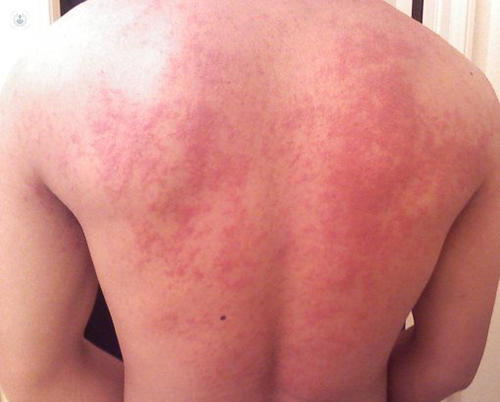dermatitis or allergic skin reaction to certain substances
Written by:Skin symptoms and signs most allergic reactions occur. In allergic patients with cutaneous manifestations two types of lesions mainly urticaria that is formed by itching and hives and in many cases is not due to allergic reactions are observed; and eczema, which are vesicles or small grains and is associated with desquamation.
Eczema is seen in contact dermatitis or allergic dermatitis. It is an inflammation of the skin caused by direct contact with a substance, for example, jewelry allergies. Eczema can also be observed in atopic dermatitis, where injuries have a typical distribution according to patient age, being more common in children and adolescents. Atopic dermatitis is a manifestation usually related to allergic patients.

Allergic contact dermatitis
Contact dermatitis can be caused by an irritating substance, which is the most common cause, and the resulting inflammation may be due to contact with acids, alkaline materials such as soaps and detergents, solvents or other chemicals. The typical lesion is the burn and the onset is usually immediate.
Instead, allergic contact dermatitis, is caused by exposure to a substance to which the patient has been sensitized and you are allergic. The reaction may appear several hours after contact and even days, and manifests as red and swollen skin, hours, takes place in small vesicles with liquid inside. Subsequently the vesicles break and a sticky liquid flowing form scabs.
When lesions of allergic contact dermatitis are prolonged in time, the skin is red and shiny and then peels, can, over time, form a thickened and dry skin lichenified.
Unlike eczema, urticaria lesions as wheal tend to disappear in several hours and no residual skin injury.
Causes of allergic dermatitis
There are multiple causes of allergic contact dermatitis. The most common is nickel and cobalt present in jewelry, watches , belts, balsam of Peru, found in some cosmetics, antibiotics and local anesthetics, applied to the skin, such as neomycin, fragrance of some colonies, formaldehyde, used as a preservative in industry and home, located preservatives in cosmetics and paints, para-phenylenediamine, ammonia and other substances used in hair dye, among many other products.
Diagnostic tests for allergic dermatitis
Based on skin lesions and a history of exposure to irritants or allergens you may suspect the diagnosis of contact dermatitis.
Conducting tests with allergic skin patches containing substances suspected exposure to the patient, help determine which is responsible for allergic contact dermatitis allergen.
Treatment of allergic dermatitis
To treat allergic dermatitis should be removed from exposure to the substance responsible for dermatitis and avoid further exposure. If the cause is secondary to occupational exposure changing workplace it will be necessary. If the substance is in the body, it should be assessed remove as much as possible.
For the prevention of future exposure it is necessary to use protective gloves and barrier creams, if exposure to the allergic substance is inevitable.
To treat lesions experts Allergology recommend performing washing and care to remove irritants that are left in the skin. In addition, you should use creams that reduce inflammation. In cases of severe injuries are associated antihistamines and even oral corticosteroids.
Edited by Patricia Crespo Pujante


